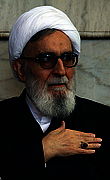Vaez Tabasi Against the Green Movement
» “Traditional Clergy Will Not Support Democracy”
The custodian of Iran’s saint Imam Reza’s shrine (Astan Ghods Razavi) in the city of Mashhad ayatollah Vaez Tabasi verbally attacked the leaders of the country’s Green Movement, calling them “leaders of the sedition” (a term the Iranian regime uses for the national uprising and massive protests over the official announcement of the 2009 presidential election) who he said were fighting Islam, strived to spread ignorance and who opposed the supreme leader.”
Speaking at the gathering of the board that organized the celebrations to commemorate the anniversary of the founding of the Astan Ghods Razavi foundation which manages imam Reza’s shrine and its finances, Tabasi said, “The rejected event that we call fetne (generally translated as sedition) and its leaders have strived for three important goals: fighting Islam, return to ignorant (pagan) values, and combating the supreme religious leader and imam of the nation.”
“If religious leadership is weakened it will be very easy to destroy Islam, spread ignorant values and alter the youth,” he proclaimed and then called for greater efforts on “Islamic ideas, the introduction of the role and position of leadership, its impact on human society, and a deep discussion on culture.”
Presented as one of the most powerful figures in the Islamic republic, ayatollah Tabasi did not publicly support any of the presidential candidates in 2009 but indicated his implicit choice when he provided a warm welcome to Mir-Hossein Mousavi during the ex-Prime Minister’s trip to the city of Mashhad where Tabasi resides.
When massive protests against the 2009 presidential elections erupted around the country, Tabasi chose to remain silent, neither expressing support for the protestors nor sending a congratulatory message to Mahmoud Ahmadinejad on his “election victory.” Because of his reticence in condemning the popular protests, he too was characterized to “lack insight” by supporters of the leader of the Islamic republic ayatollah Khamenei.
On January 20, 2010 the conservative pro-government Hemat weekly published by a group of individuals close to Gholam-Hossein Elham (former government spokesman during Ahmadinejad’s administration) and his journalist Fateme Rahimi published a photograph of Tabasi along with Hashemi Rafsanjani, Mir-Hossein Mousavi, Mehdi Karoubi, Nategh Nouri, Mohammad Khatami Ali Larijani, Mohammad-Bagher Qalibaf and other political and religious leaders in the Islamic republic of Iran presenting him as a supporter of the protest movement.
It is noteworthy that just 10 days earlier, Tabasi had labeled the organizers of the protests on Ashura last year to be enemies of God, whose fate he said was clear in the Islamic republic.
In a talk that he delivered then, this member of the powerful Assembly of Experts on Leadership added, “This is a small group of people who are under the gun. If they do not repent their actions, if they do not ask for forgiveness from people, if they do not ask for amnesty from the leader of the revolution, it will be too late.”
Amin Bozorgnia, an Iranian social analyst residing in France, wrote that Tabasi has been under pressure to denounce the demonstrations. He said conditions in Iran were black and white where one had to either speak against the protest movement which would put him inside the “inner circle” of the regime, or remain silent, which would then make him to be with “them,” i.e., the protestors or enemies. According to Bozorgnia, Tabasi say these things to preserve their positions within the power structure of the regime. “Under the present conditions, there is no difference between Tabasi and Ahmad Tavokoli (a conservative member of the Majlis) in their opposition to the Green Movement,” he said.
In their protests and statements, Mir-Hossein Mousavi, Mehdi Karoubi, Mohammad Khatami, Hashemi Rafsanjani and many other protestors have repeatedly stressed that senior clerics in Iran are “unhappy” with the current state of affairs, and observers believe that the leaders of the protest movement rely on these individuals to support them.
Tabasi is one of those clerics who has on many occasions publicly criticized Ahmadinejad administration’s performance during the last 6 years. So the big question is whether his recent remarks against the green movement and protestors demonstrate the failure of the protestors in gaining the support of the senior and powerful clerics?
Bozorgnia says that traditional conservative clerics cannot be significantly helpful to the Iranian democracy movement. He believes that it is an illusion to believe that these clerics will support the reformists. The world in which conservative clerics live and the one in which a pro-democracy activist plays are two different realms. He adds that these clerics are not concerned with democracy and whether it is beneficial or whether dictatorship is harmful. Bozorgnia points out that these very clerics, who today have been criticizing Ahmadinejad’s administration, were also against the democratic reforms that Mohammad Khatami’s reform administration was promoting. The criticism that conservative clerics have regarding Ahmadinejad’s administration stems not from democratic perspective but from fundamentalist beliefs.
Bozorgnia concludes that someone like Mousavi can take advantage of ayatollah Safi Golpaygani’s criticism of Ahmadinejad but this should not create the illusion that a shift has taken place in favor of democracy and human rights among conservative clerics.


